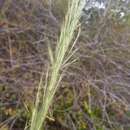pt-BR
nomes no trilho de navegação


Aristida rufescens is a grass species native to Madagascar and to Mayotte in the Comoros archipelago.[3] It was described by German agrostologist Ernst Gottlieb von Steudel in 1854.[1]: 421 [2]
The species is a perennial bunch grass with short rhizomes. Its culms are erect and 70–100 centimetres (28–39 in) long, with swollen nodes and hairy leaf sheaths. Leaf blades are 30–40 centimetres (12–16 in) long and 3 mm wide; they are stiff, leathery, and convolute. The inflorescence is a panicle in which each spikelet contains one fertile flower. Spikelets are lanceolate and 8.5 mm long. Upper and lower glumes have 1–2 mm long awns, and lateral lemmas have a 13–14 mm long awn,[4] which is three-branched.[5]: 27 The grass is a C4 plant.[6]
Aristida rufescens is one of the dominant species in the grasslands of the central high plateaus of Madagascar.[6][7] It is extremely fire-tolerant; although of poor quality when mature, young resprouts after fire are protein-rich cattle feed in the September to November "hungry season". In Malagasy, it is known locally as horona, horombohitra, kofafa vavy, horombavy, or pepeka. It is used for roofing and broom-making,[8] and its ash for medical ointments.[5]: 27
Aristida rufescens is a grass species native to Madagascar and to Mayotte in the Comoros archipelago. It was described by German agrostologist Ernst Gottlieb von Steudel in 1854.: 421
The species is a perennial bunch grass with short rhizomes. Its culms are erect and 70–100 centimetres (28–39 in) long, with swollen nodes and hairy leaf sheaths. Leaf blades are 30–40 centimetres (12–16 in) long and 3 mm wide; they are stiff, leathery, and convolute. The inflorescence is a panicle in which each spikelet contains one fertile flower. Spikelets are lanceolate and 8.5 mm long. Upper and lower glumes have 1–2 mm long awns, and lateral lemmas have a 13–14 mm long awn, which is three-branched.: 27 The grass is a C4 plant.
Aristida rufescens is one of the dominant species in the grasslands of the central high plateaus of Madagascar. It is extremely fire-tolerant; although of poor quality when mature, young resprouts after fire are protein-rich cattle feed in the September to November "hungry season". In Malagasy, it is known locally as horona, horombohitra, kofafa vavy, horombavy, or pepeka. It is used for roofing and broom-making, and its ash for medical ointments.: 27
Aristida rufescens là một loài thực vật có hoa trong họ Hòa thảo. Loài này được Steud. mô tả khoa học đầu tiên năm 1854.[1]
Aristida rufescens là một loài thực vật có hoa trong họ Hòa thảo. Loài này được Steud. mô tả khoa học đầu tiên năm 1854.